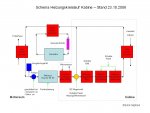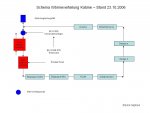egn
Adventurer
In the photo, there is a valve at the bottom of the tank. That is the "thermostatically controlled valve," isn't it ?
Yes, this is this thermostatically controlled valve mentioned above. It mixes hot water from tank with cold water.
There looks to be another control near there (a blue/grey box with a control lever). Is that related to the water temperature control ?
This is a electrically controlled 3-way valve to switch between summer and winter operation. In summer the hot water from the Webasto flows only through the Isotemp. In winter it flows after the tank also through the heating pipes and convector. This valve has been replaced later by a manual 3-way valve, because this was easier to handle.
I have attached two schematic drawings to give you an idea. Sorry for being in German language. Please feel free to ask any questions.
Attachments
Last edited:




